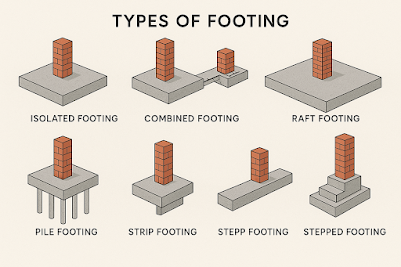How to calculate Concrete Quantity Required for House
- Get link
- X
- Other Apps
Concrete quantity is calculated by finding the volume of each basic component where it is utilized. The standard unit for concrete quantity is cubic meters (m³).
Step-by-Step Direct to Calculating Concrete Quantity
Start by assessing the structural plans and preliminary design drawings of the house. Recognize all components that will utilize concrete. Regularly,
these include:
1. Establishment (Footings, Plinth Beam)
2. Columns
3. Beams
4. Chunk (Roof/Floor)
5. Staircase (on the off chance that applicable)
Each of these components has a particular volume, and their
combined volume gives the add up to amount of concrete required.
Step 2: Take Estimations and Dimensions
You’ll require to collect or calculate the measurements of each
component. Utilize meters as the unit for consistency. Normal measurements to
note:
Length (L)
Width (W)
Tallness or Profundity (H/D)
Take measurements with a tape or reference the design
drawing
Step 3: Calculate Volume of Each Element
Let’s see at equations and cases for each element.
1. Establishment (Footings)
If utilizing disconnected footings (common for column-based
houses):
Volume of one balance = L × W × D
Multiply by the number of footings.
Example:
For 10 footings, each 1.5 m × 1.5 m × 0.5 m:
Volume = 10 × 1.5 × 1.5 × 0.5 = **11.25 m³
2. Columns
Volume = Volume = length × width × × Height
Example:
10 columns of measure 0.3 m × 0.3 m × 3 m:
Volume = 10 × 0.3 × 0.3 × 3 = **2.7 m³
3. Beams
Volume = width × profundity × length
Include all bars and increase accordingly.
Example:
6 pillars of 0.25 m × 0.4 m × 4 m:
Volume = 6 × 0.25 × 0.4 × 4 = **2.4 m³
4. Slabs
Volume = length × width × thickness
Typically chunks are around 0.125 m (5 inches) thick.
Room of estimate 5 m × 4 m:
Volume = 5 × 4 × 0.125 = 2.5 m³
For a entirety floor piece, include volumes of each room or
consider add up to area.
5. Staircase
More complex, but generally:
Volume ≈ number of steps × tread × riser × width
Or inexact the whole staircase as a strong block.
Example:
20 steps, each 0.3 m tread, 0.15 m riser, 1 m width:
Volume ≈ 20 × 0.3 × 0.15 × 1 = 0.9 m³
Step 4: Include All Volumes Sum all person volumes:
|
Component |
| Volume (m³) |
|
Footings |
11.25 |
|
Columns |
2.7 |
|
Pillars |
2.4 |
|
Chunk |
2.5 |
|
Staircase |
0.9 |
|
Add up to |
19.75 m³ |
|
|
|
Concrete is subject to dealing with misfortunes. Include
5–10% extra:
Wastage = 19.75 × 0.1 = **1.975 m³
Total concrete required = 19.75 + 1.975 = approx. 21.73 m³
If you need to break down the amount into blend components
(e.g., M20 blend: 1:1.5:3):
Add up to portion = 1 + 1.5 + 3 = 5.5
Cement portion = (1 / 5.5) × 21.73 ≈ 3.95 m³
1 m³ of cement = approx. 1440 kg
So, Cement bags = 3.95 × 28.8 ≈ 114 bags
You can also determine the quantities of sand and aggregate
using their mix ratios and densities
Tips for Accuracy
* Continuously confirm measurements from last drawings.
* Consider whether concrete will be blended on-site or
requested from a ready-mix plant.
* For complex shapes (like arches, bended stairs), break
them into littler known shapes or counsel a basic engineer.
* Utilize computerized devices (spreadsheets, development
estimation program) for expansive projects.
Conclusion
Calculating the amount of concrete required for a house
includes understanding the structure, measuring measurements, computing
volumes, and summing them up. Continuously permit for wastage and affirm with a
proficient some time recently obtainment. Precise concrete estimation makes a
difference in budgeting, planning, and smooth venture execution. Let me know if
you need a test Exceed expectations sheet or equation layout.
- Get link
- X
- Other Apps
.png)
.png)

Comments
Post a Comment